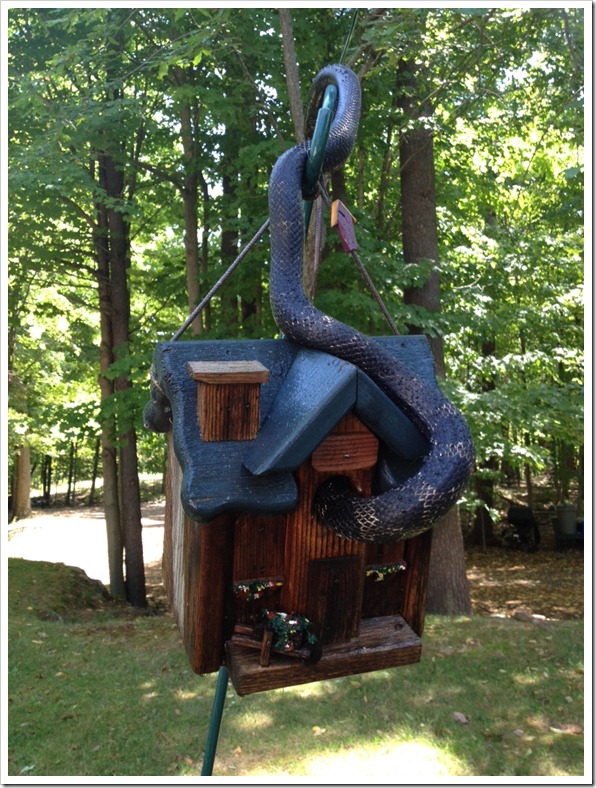Written by
Anne Timmons posted on October 13, 2012 07:41
“Oh my God! That’s disgusting. That snake is going to get into the birdhouse”, my sister-in-law screamed.
We had been watching as a six foot long Black Ratsnake poked his head out of a hole in the old maple tree and made his way down the gnarly trunk. The pileated woodpeckers had inadvertently given him a safe haven.

“Oh my God! That’s disgusting. That snake is going to get into the birdhouse”… Yes, he did!
Photo by Lisa Beaulieu
|
Birds were in a frenzy pecking his head but he was not to be deterred. Step by step, inch by inch he slithered towards their home, wrapping and pulling himself up the green iron pole. Dangling only six feet from the ground the miniature cottage for the wrens was going to become a snake feeder.
“I’ll get the hose and try to scare him away,” I said. As the water hit him the snake appeared to glance at me in annoyance but was unstoppable.
Looking on in horror we watched the snake fit his whole body into the two inch opening of the birdhouse. The chirping stopped. Satiated the snake seemed to give a look of defiance as he made his way across our backyard continuing his migration across Hill Island. This was the climax to a very stressful week.
The Black Ratsnake had been hanging around our cottage since the 4th of July. Initially observed creeping across our septic field near the edge of the woods no one was concerned.
He was an impressive specimen with his shiny black skin and white throat. Farmers particularly like having Black Ratsnakes around because they are not poisonous and eat rats, mice, bugs, and other pest animals. We learned that they also eat birds and their eggs.
Our Black Ratsnake began to wear out his welcome when he was mistaken for windshield wipers while repeatedly sunning himself on the hood of our car. It was unsettling when we saw his tail wagging from beneath the car engine. Black Ratsnakes are at risk and protected but we were hard pressed not to take drastic measures when he started climbing up the back stairs to the porch. Until we saw him leave that fateful day we were on edge every time we stepped outside.
Abandoned rock quarries, open grassy fields, abundant rock crevices, plush forests, natural leaf piles and hollow logs. Who knew Hill Island would be the perfect habitat for the Black Ratsnake? We didn’t but we sure do now.
The Black Ratsnake is found in four distinct populations including Eastern Ontario, adjacent New York, the Great Lakes and St. Lawrence region. It is Canada’s largest snake.
Females begin nesting in early July and August hiding their eggs in hollow logs or under leaves. The Ratsnake’s active season extends from the middle of April to mid-October. They are excellent climbers. During the remainder of the year they hibernate in communal underground sites. The species is protected provincially under Ontario’s Fish and Wildlife Conservation Act and Endangered Species Act as well as the National Parks Act. Although they are non-venomous Ratsnakes are still being intentionally killed. People fear their large size.
Adult Black Ratsnakes are strongly attached to their territory and often return to the same sites from year to year. These snakes can live up to 25 to 30 years but only lay batches of 10 to 15 eggs late in their life cycle every two or three years. Looking back we wonder if our visitor was the same snake we observed in a hemlock tree next to our cottage several years ago.
Little did we know to expect regular visits. Next year we will be emotionally prepared.
By Anne Timmons
Anne Timmons grew up in Nyack, Long Island, and Syracuse, NY. She, her husband Jeff, and sons Jake and Luke, had spent many years camping in the Islands. After buying a buying property on Wallace Island (Canadian Sector) in 1982, a move to Hill Island came in 1998. Currently residing near Philadelphia, Anne, has recently retired from a thirty-five-year career in New York's Office of People with Developmental Disabilities. Retirement has given her the opportunity to take writing courses, and to write about the Thousand Islands.